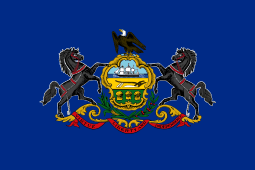151st Pennsylvania Infantry
| 151st Pennsylvania Volunteer Infantry | |
|---|---|
|
Pennsylvania flag | |
| Active | September 1862 – July 27, 1863 |
| Country |
|
| Allegiance | Union |
| Branch | Infantry |
| Engagements |
Battle of Chancellorsville Battle of Gettysburg |
The 151st Pennsylvania Infantry was a Union Army regiment during the American Civil War. It was given the moniker of "The Schoolteachers' Regiment" because of the large enlistment of school instructors, predominately in Company D.
History
Forming of the Regiment
The regiment was recruited from across the Commonwealth of Pennsylvania during the early fall of 1862, with companies raised from the following counties:
- Companies A and C, Susquehanna County;
- Company B, in Pike County;
- Company F, Warren County;
- Company D, Juniata County;
- Companies E, G, H, K, and part of I, Berks County
- Remainder of Company I, Schuylkill County.
Harrison Allen, formerly major of the 10th Pennsylvania Reserve Regiment, was elected colonel of the regiment. George F. McFarland of Company D was elected lieutenant colonel. John W. Young of Company C was elected major.
Early Service
The regiment was moved to Washington, D.C. at the end of November, and the following month to Union Mills, Virginia, where it fell into winter quarters with the Army of the Potomac. In mid-February, the regiment was formally assigned to the Third Division of the I Army Corps as part of a replacement for the departing Pennsylvania Reserves, which was recalled to the defenses of Washington.
Chancellorsville
The 151st's first engagement occurred at Chancellorsville, where it maintained a picket line on the mostly inactive I Corps' right flank. The regiment guarded the crucial Rapidan River crossing at United States Ford, taking prisoners on a small incursion with Brig. Gen. Francis T. Nicholls Louisiana brigade of Lt. Gen. Thomas J. Jackson's corps.
Gettysburg
The regiment next fought at the Battle of Gettysburg, with Lt. Col. McFarland still in command. The regiment defended the Union left on McPherson's and Seminary Ridges. Confederate attacks forced the I Corps to retreat through Gettysburg. During the fighting near the Seminary, the regiment took cover near a barricade and held off several more Confederate attacks. Lt. Col. McFarland was at the front of the regiment, leading his men. The gunsmoke was so thick that McFarland couldn't see the enemy through it. He crouched down to see under the smoke and track the Confederates' movements. It was then that a Rebel bullet went through one of his legs and through the other as he crouched down. A private of Co. F attempted to carry McFarland back to the Seminary for treatment, as it was then being used as a hospital. The private nearly lost his life when a bullet came so close that it sheared off one of the brass buttons on his cuff. McFarland was kept safely inside the Seminary for several months after the battle.
The regiment reformed on Cemetery Hill with only 113 officers and men left, with a captain in command. It was assigned a position on the left of the II Corps, where on July 3, it helped repulse the Confederate attack. During the battle, the regiment lost 367 out of 478 officers and men, a rate of nearly 75%. Allen arrived that day to re-assume command of the regiment, which then participated in the pursuit of the Confederate army. Following the conclusion of the campaign, it was sent to Harrisburg on the 19th and mustered out on the 27th.
Legacy
The 151st is held in high regard in Juniata County where Company D was formed. A plaque across the street from the old McAlisterville Academy where Lt. Col. McFarland and other members of the regiment taught memorializes the regiment and its actions at Gettysburg. A reenacting unit from Juniata County portrays Company D of the regiment.Of their actions at Gettysburg on July 1st and 3rd General Abner Doubleday, who temporary commanded the 1st Corps at Gettysburg, said of the regiment:
"At Gettysburg, they won, under the brave M'Farland, an imperishable fame. They defended the left front of the First Corps against vastly superior numbers; covered its retreat against the overwhelming masses of the enemy at the Seminary, west of the town, and enabled me, by their determined resistance, to withdraw the corps in comparative safety. This was on the first day. In the crowning charge of the third day of the battle, the shattered remnants of the One Hundred and Fifty-first Pennsylvania, with the Twentieth New York State Militia, flung themselves upon the front of the rebel column, and drove it from the shelter of a slashing in which it had taken shelter from a flank attack of the Vermont troops. I can never forget the services rendered me by this regiment, directed by the gallantry and genius of M'Farland. I believe they saved the First Corps, and were among the chief instruments to save the Army of the Potomac, and the country from unimaginable disaster." [1]
Casualties
- Killed and mortally wounded: 2 officers, 67 enlisted men
- Died of disease: 1 officer, 53 enlisted men
- Total: 3 officers, 120 enlisted men
See also
References
- Sources
- Unit history from the Pennsylvania in the Civil War site
- History of the regiment (Archived 2009-10-19)
- Sears, Stephen W. Chancellorsville. Boston: Houghton Mifflin, 1996. ISBN 0-395-87744-X.
